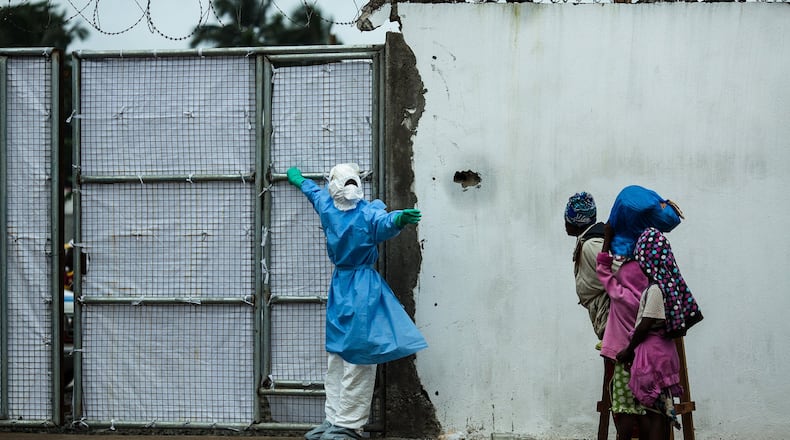You know you're in for a novel museum experience when your visit begins with a full car inspection and an ID check. The Centers for Disease Control and Prevention's David J. Sencer Museum is no ordinary art space, from that requisite security check to the global health perspective that informs this CDC lobby museum space.
"Ebola: People + Public Health + Political Will" proves once again the unique vantage offered by this museum in an exhibition centered on the modern pandemic of Ebola and the devastating 2014 outbreak that ravaged Guinea, Sierra Leone and Liberia. These were already three of the poorest countries on Earth, crippled by waves of civil war and deeply broken infrastructure, so the outbreak of Ebola in a 2-year-old child in Guinea occurred in a region poorly equipped to handle the crisis. Over the course of the outbreak's two-year run, 11,000 people died from the outbreak, many of them the local health care workers who sacrificed their lives to help others, in addition to a heroic cadre of international medical teams.
RELATED | Making history inside Emory's Ebola unit
Copious wall text (didactic wall labels are the primary communicative form here) affirms that stopping a global health crisis was central to the international community’s actions in West Africa during the Ebola outbreak. But also at work was a global, moral imperative to do the right thing that drove aid agencies and governments around the world, including the United States’ CDC and its Department of Defense, the World Health Organization, the United Nations and organizations like UNICEF and Doctors Without Borders. Even Muslim and Christian clergy worked to defy regional prejudices and entrenched belief systems by finding a rationale for fighting Ebola in their religious teachings.
Art exhibitions rarely have a moral, but this one does: When tragedy strikes in one corner of the world, it is the responsibility of more privileged nations to step in and help. With its mix of world-class photography; lab equipment; wooden tools used in local burials; the elaborate Personal Protection Equipment (PPE) donned by health workers in the field fighting Ebola; diaries of health workers and in-country briefings; audio testimony from CDC responders; and educational materials, among many other elements, the exhibition is a powerful multimedia testament to the global cooperation involved in defeating this crisis.
Difficult realities also impeded the spread of information about the disease, including remote villages, public distrust in institutions, and long-established traditions such as burial customs and folk medicine. Fighting Ebola, this exhibition affirms, was not just a public health matter, but a public relations, diplomatic and logistical puzzle. Some of the most fascinating elements in the exhibition are artist-made murals, but also government-disseminated comics and posters that in frank and graphic ways, informed the public about how to prevent and contend with the spread of Ebola, from hand-washing to avoidance of “bushmeat,” the wild animals such as bats, primates and cane rats — whose hunting, butchering and processing was the likely source of the virus jump from animal to human.
The experience of visiting “Ebola: People + Public Health + Political Will” is fairly complex; by turns enlightening, heartbreaking, horrifying, but also surreal for Western audiences buffered by oceans and prosperity from the cataclysm that consumed West Africa. The exhibition may be the first real encounter with something many of us experienced in headlines and news reports, more as an abstraction unfolding far away.
“Ebola” also attests to the lasting toll of the outbreak. Ebola’s effects endure: 16,000 children lost parents and the emotional, psychological and economic hardships that befell its victims lingered long after the outbreak was contained.
ART REVIEW
“Ebola: People + Public Health + Political Will”
Through June 15, 2018. 9 a.m.-5 p.m. Mondays, Tuesdays, Wednesdays, Fridays; 9 a.m.-7 p.m. Thursdays; closed weekends and federal holidays. Free. David J. Sencer CDC Museum, 1600 Clifton Road NE, Atlanta. 404-639-0830, www.cdc.gov/museum.
Bottom line: Grim, fascinating deep dive into the devastating 2014 Ebola outbreak in West Africa.
About the Author
Keep Reading
The Latest
Featured




